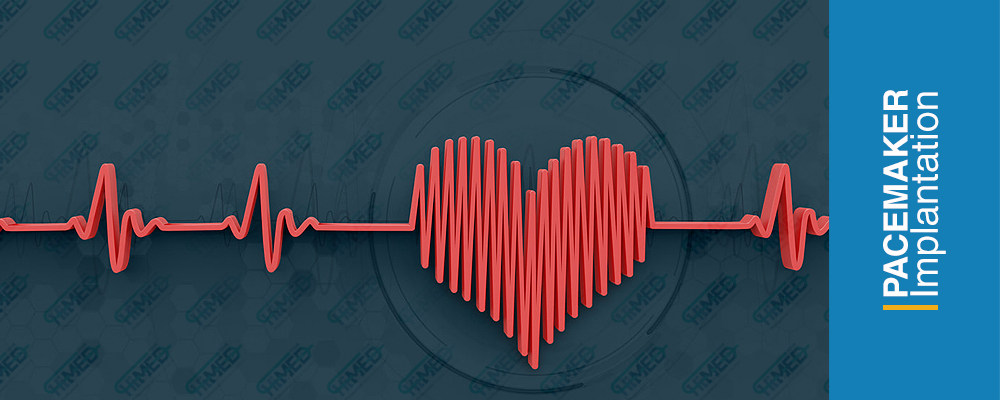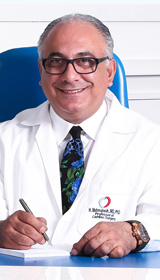
Pacemaker Implantation
5min ReadAn artificial pacemaker is a small device placed under the patient’s skin to regulate their heartbeat. If you suffer from arrhythmia (irregular heartbeat), a pacemaker can help restore your heart’s natural rhythm. A pacemaker can be placed either temporarily or permanently. It is implanted temporarily for patients who misused heart medicine or suffered from a heart attack and permanently for patients with congenital disorders or heart failure.
First, let’s see how the heart works. This muscular organ is the size of a fist and has four chambers, two at the top called “atria” and two at the bottom called “ventricles”. The heart has its own pacemaker, which means it regulates its own beat and rhythm through an electrical nerve system. This electrical system starts at a node atop the right atrium and sends impulses down to the rest of the heart, causing it to contract and pump blood. Damage to the heart muscle caused by heart attack, misuse of heart medication, genetic disorders, or simply old age can disrupt this natural rhythm.
How do artificial pacemakers work?
Artificial pacemakers are very similar to our natural pacemakers, they are made up of two parts:
- The pulse generator: This part contains batteries and the pulse generator.
- The leads: 1-3 wires placed in the chambers of the heart, they guide the produced pulse to the heart.
The pacemaker will not always be active and will only send signals when needed. For example, it will send signals when your heart beat is too low. It will wait patiently, assess your heart’s function and will only jump into action when a problem occurs.
Modern pacemakers have many advanced mechanisms, they asses things such as the rate of your breathing and your body’s condition and react accordingly. For example, a modern pacemaker would increase your heart rate during exercise.
Paraclinical testing
Before the pacemaker implantation, your physician will prescribe a few tests to find the cause of your arrhythmia. These include:
- EKG
- Holter monitoring: A holter monitor is a device that records your heart’s activity throughout the day (24-48 hours).
- Echocardiography: A test that uses sound waves to assess your heart and valves’ function.
- Cardiac stress test: Assesses your heart’s function when it is under stress.
Preoperative care, the surgery, and postoperative care
Before the procedure
If you’ve never had a surgery before, don’t worry, we’ll take you through the process step-by-step. The nurse will ask you to use the bathroom to empty your bladder and wear your hospital gown. You will be taken to the surgery room where you’ll lie on your back on the operating table. An intravenous line (or catheter) is inserted into a vein to help with the administration of fluids and drugs throughout the procedure. Usually, this procedure is done without general anesthesia but you will be given sedatives to keep you relaxed. The surgeon will then begin the implantation process
The pacemaker implantation procedure
The best way to access the heart is through vessels. Deciding which vessel to use will be up to your physician. Surgeons usually prefer to use the subclavian vessels, vessels that are under your collarbone. This area is then covered by a special cloth and disinfected. A nurse might need to shave the area to avoid infection. Local anesthesia is applied to the area and a small 3-5 cm incision is made.
The surgeons will insert and guide the lead wires through the vessels and to the heart. X-ray imaging will help the surgeon guide the wires through the right path and attach them to the right locations on the heart. The other ends of these wires are attached to the pulse generator which is then placed under the skin at the site of the incision. So basically one end of the lead wires is attached to the chambers of the heart and the other to the pulse generator.
This procedure could take 1-3 hours, but don’t worry, the sedatives won’t let you feel a thing!
After the procedure
You will be in the hospital for one day or maybe more, depending on the physician’s opinion. You may have to stay in the CCU so that medical staff can take better care of you. The pacemaker’s settings will be calibrated according to your condition. Most pacemakers can be controlled remotely. They can send data to your physician which can further help them assess the situation.
Your physician might tell you to avoid lifting heavy objects and strenuous exercise for up to a month after the procedure. Avoid putting pressure on the area where the pacemaker has been implanted. If you feel pain in this area, consult your physician about taking painkillers.
Inform your dentists and physicians that you have a pacemaker because diagnostic tests and treatment methods such MRI, radiotherapy and many others may disrupt the function of the pacemaker.
You must visit a cardiologist every 3-6 months to evaluate the condition of the pacemaker. Inform your physician if you experience any of the following: increase in weight, swelling in the legs, fainting, or headaches.
Important notes regarding pacemaker implantation
Side effects
Side effects are not very common but they may include:
- Infection of the surgical wound
- Allergic reaction to the contrast agent or anesthetic during the procedure
- Swelling or bleeding at the surgical wound, specially if the patient takes blood thinners
- Damage to the nerves or vessels near the pacemaker
- Damage to the lungs
Pacemaker malfunction
To prevent pacemaker malfunction pay attention to the following points:
- Using your cellphone is okay, just make sure to keep it at least 15 cm away from the pacemaker.
- When speaking on the phone, hold it on the ear opposite to the pacemaker so that it isn’t close to it.
- Passing through metal detectors such as the ones in airports is okay, although the detectors might beep when you pass through them. Just don’t stay near these devices for too long.
- Stay at least half a meter away from generators and devices with high voltage. If you work somewhere where you have to be in contact with these machines and devices, ask your physician to perform a test in your workplace to see if it’s okay for you to work there.
- Don’t worry about using TVs, radios, electrical kitchen appliances, etc. They won’t do you any harm.




Reviews
Number of pending reviews175